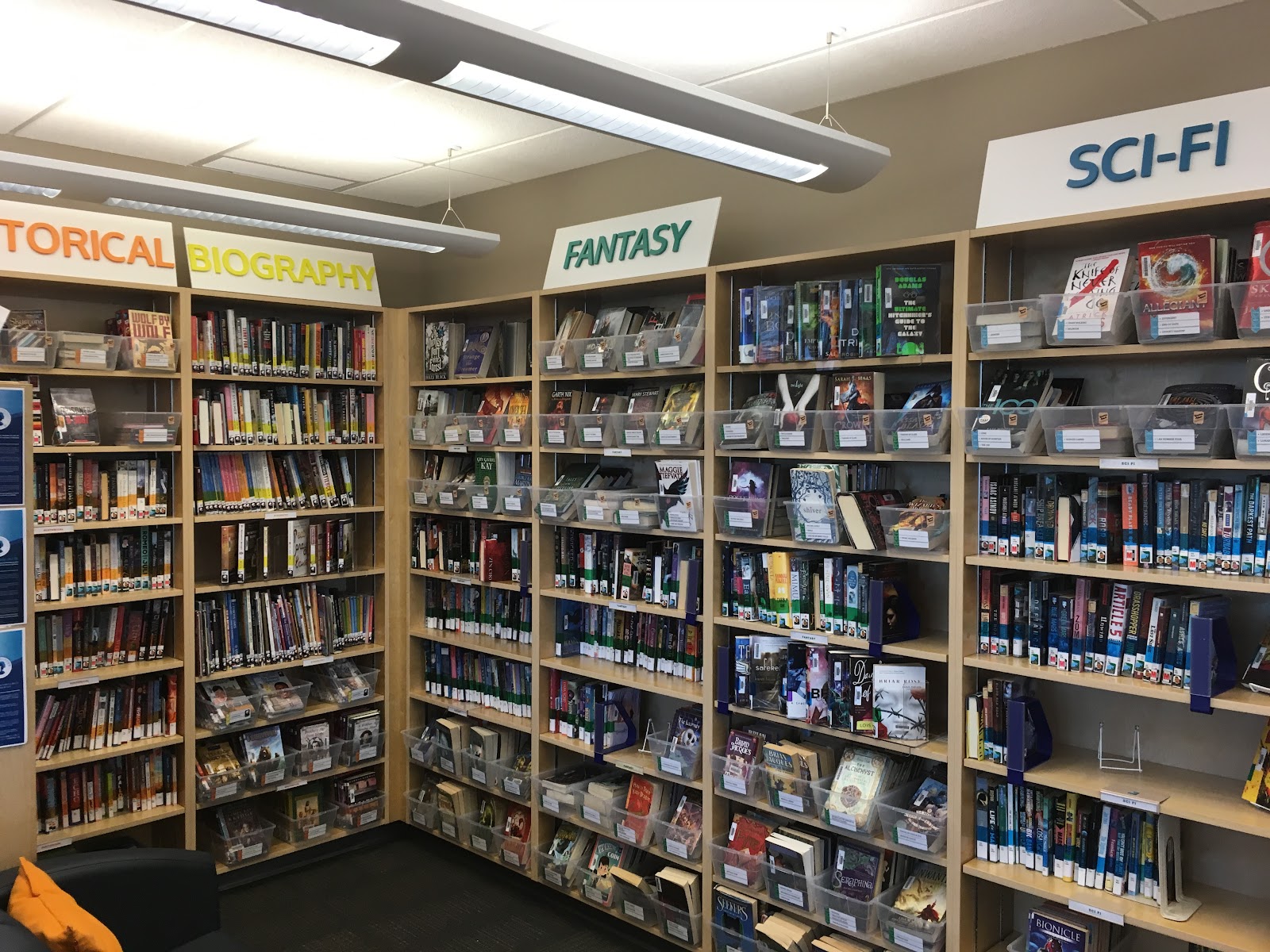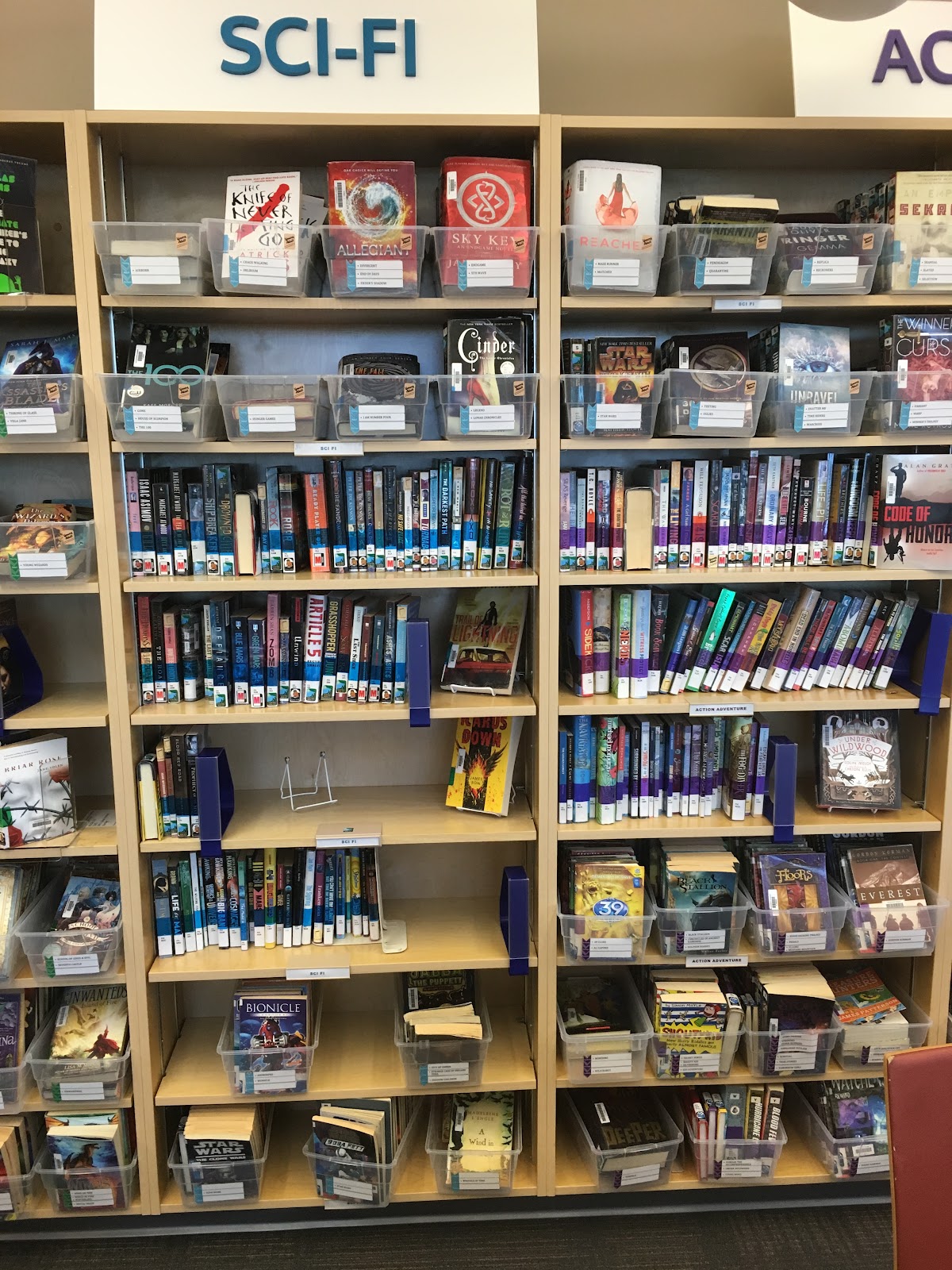Genrefying the Fiction Collection
~contributed by Pam McMartin - Southpoint Academy
Two years ago, we completed a major weed and inventory of the fiction section of our K-12 library. During this process, we noticed how there was a group of titles (largely series) that were frequently checked out and many titles that were being overlooked by the students. In some cases this was because the titles were old, or not relevant to our student body and needed to be weeded from the collection, but many of the titles were hidden gems that were being overlooked by our students. In reflection, we realized that the word hidden was key to why these titles were not getting checked out and we began to wonder if the current organizational system in our library was hindering students from discovering many of these titles.
There has been significant interest in genrefying the school library in recent years and I have read numerous article on the topic and have attended numerous Pro D sessions and webinars on the topic. While genrefying the collection may not work for all libraries, for us it seems to be solving some of our circulation issues.
 What Does it Mean to Genrefy a Fiction Collection?
What Does it Mean to Genrefy a Fiction Collection?Our Fiction section in our library used to be sorted simply by reading level (E (Early Reader), Juvenile, Young Adult, or Mature) and shelved alphabetically by author’s last name. When a library is genrefied, the books are shelved in genres, similar to a how a bookstore would operate.
Why Did We Decide to Genrefy our Collection?One of our main reflections after analyzing our circulation statistics was that students may not be checking out books because they were not discovering them. They were often defaulting to series because we knew the series. We found that students were more likely coming to us asking for book recommendations based on genre and not on authors (the way our fiction system was originally organized). When students asked us for a recommendation for a good mystery book to read, we often defaulted to the first titles that came to our mind because we could find them on the shelves and many great titles were being overlooked. After genrefying our collection, when a student asks us for a great mystery read, we can direct them to the Mystery section where they can browse the shelves and discover titles they may not have discovered before. This plays on the browsing philosophy book stores employ - organize the books by genre to make it easy for patrons to browse based on their interest in a specific genre and discover books on their own.
How Did We Genrefy our Collection?The process of genrefying our collection was quite a long one and took several months.
1.)We completed an evaluation of our collection and weeded titles that were damaged, outdated, or no longer needed in the collection - this allowed us to know how many books we were dealing with.
2.)We decided on our broad genres. For the purposes of our library we decided on the following genres:
- Realistic
- Historical
- Biography (not technically fiction, but we felt the biographies and autobiographies would get more circulation if shelved in the fiction section).
- Fantasy
- Sci-Fi
- Action
- Mystery
3.) Once we decided on our genres, we developed a system of labelling we felt would work for our students. We assigned each genre a colour, purchased spine labels in each colour that we would put on the book spines of each books so students knew which genre it belonged to and so people shelving would know what section to put the book in and ordered signage for the library with the genre names in the appropriate colour.
4.) We then started the task of sorting each book into a genre - which took months! For some books it was easy, but for other books it was more difficult (I am looking at you Vonnegut!) For those books that didn’t easily fit into a genre easily, we went with the genre we thought would make the most sense for our student body with the caveat that we could always change it later if our decision wasn’t working.
5.) The last task was the most time consuming. Once we sorted each of the books into a category, we had to map out our shelf space with the number of books in each category to figure out what should go where. For example, our Realistic section was quite large, but our Mystery section was significantly smaller. Besides letting us know how much shelf space was needed, this step of the process also gave us an excellent visual of sections of the collection where we need to develop more choice for students. We needed to ensure we assigned enough shelves for the number of books we had, but also allowed room on the shelves for the section to grow as it wouldn’t be a simple matter of just shifting books once the collection was genrefied and the shelves were labelled. Once we had the shelves mapped out, we added the colour coded stickers to each book, sublocated them in the library catalogue to the appropriate genre, and shelved them.
What Have Been Some of the Benefits We Have Noticed Since We Have Genrefied Our Collection?We have found right away that some of the books that have never been checked out have started to move from our shelves. When a student asks for a Sci-Fi book, we can easily direct them to the Sci-Fi section and they are started to explore more rather than just defaulting to a popular series. Because of this, students are starting to discover some of our previously hidden gems. We have also found that students are starting to explore the library more and are challenging themselves to explore genres they may have never considered before.
What Have Been some of the Challenges?The largest challenge for us seems to be what to do with authors that write across genres and we decided we had to deal with this on a case by case basis on what would be best for our students. For some authors, like Roald Dahl, we decided to keep all of his books together in the genre the majority of the books were written in. We did this because our students were more likely to ask for Roald Dahl books based on the author because he was one they were familiar with. For other authors we decided to break their books up across genres because the students were not recognizing their books by the name of the author, rather they were more likely to recognize them by the genre they are in. Making these decisions took some time and we likely will have to make some adjustments as time goes by.
Overall, despite the large amount of work involved, genrefying the fiction section of our library has been a worthwhile endeavour that has revitalized sections of our collection and has allowed our students to explore our collection and to find their next great read with greater ease.
